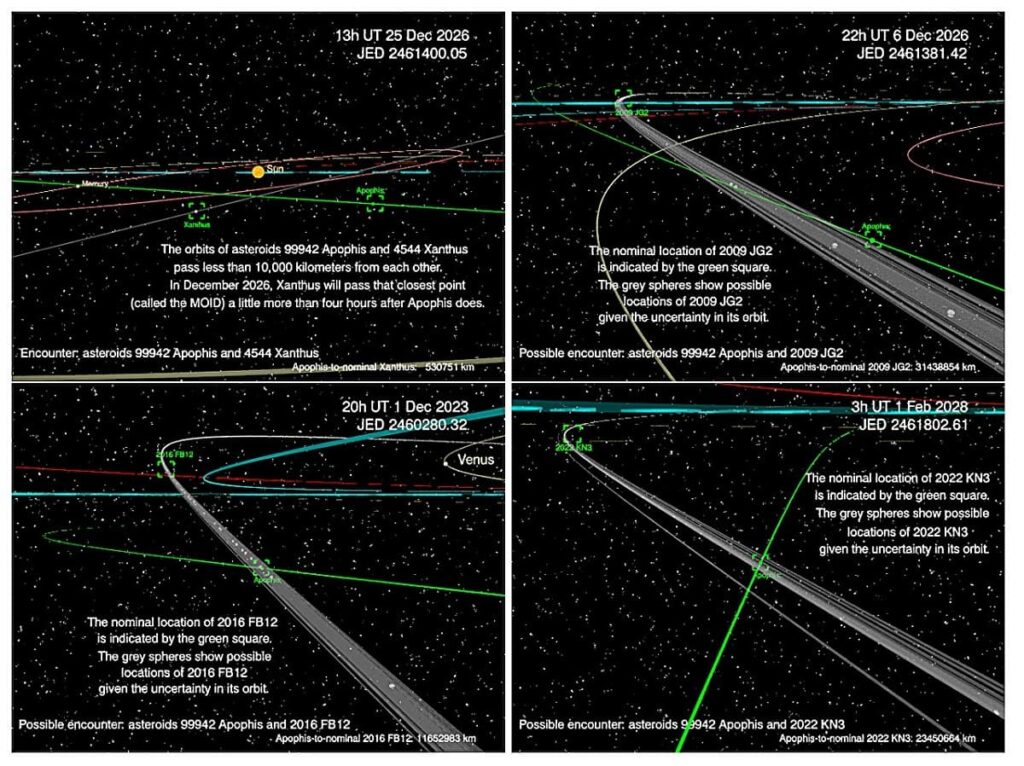Since its discovery in 2004, the asteroid Apophis, dubbed the “God of Chaos,” has been a subject of fascination and concern for astronomers worldwide. Its looming proximity to Earth in 2029 has sparked intense interest and meticulous scrutiny. But here’s the spoiler alert: we’re in the clear!
Tracking Apophis: A Reassuring Trajectory
As a Near-Earth Object (NEO) measuring approximately 335 meters in diameter, Apophis has gained notoriety for its upcoming close encounters with our planet, particularly in 2029 and 2036. On April 13, 2029 (yes, Friday the 13th!), it will swing by at a mere 37,399 kilometers from Earth’s surface. While this might seem uncomfortably close on a cosmic scale, rest assured, unless there’s a significant alteration in its course, we’re safe.
This impending flyby presents an unprecedented opportunity for scientists. Without the need for a dedicated space mission, they can observe and study an asteroid of this magnitude up close. Direct observation promises insights into its composition, structure, and celestial dynamics.
Despite initial concerns, extensive studies have debunked any fears of a potential collision with our planet. Refined trajectory calculations, based on years of observations and analyses, affirm that Apophis poses no threat to Earth for the foreseeable future.
Paul Wiegert, lead author of a recent study, remarks, “Apophis has intrigued us since its discovery in 2004. It posed the first credible threat from an asteroid to our planet.” Even with the reassurance of its near miss, astronomers remain vigilant. As Wiegert puts it, “It’s the asteroid we just can’t stop watching.”
Risks of Indirect Collisions: Assessing the Unlikely

But how can researchers be so certain of this negligible risk? An asteroid’s trajectory through space is influenced by various factors, including gravitational interactions with other celestial bodies. Concerns arose regarding the potential impact of a collision with another asteroid on Apophis’s path.
Hyatt, an undergraduate student at Waterloo who contributed to the research, explains, “Given Apophis’s close approach to Earth, there’s a conceivable risk that a deviation in its current trajectory could bring it closer to our impact zone.” He adds, “Hypothetically, another asteroid colliding with Apophis could trigger such a deviation, prompting us to study this scenario, however improbable it may be.”
This concern drove a detailed analysis of the trajectories of 1.3 million known asteroids. The goal was to definitively identify any objects capable of intersecting Apophis’s path and potentially altering its course.
The results of this exhaustive study provide considerable assurance. None of the asteroids cataloged in the solar system will collide with Apophis before its 2029 approach. This conclusion stems from complex simulations of orbital dynamics, accounting for the positions and movements of all known asteroids.
By ruling out the possibility of a disruptive collision, researchers have confidently confirmed that Apophis’s trajectory poses no imminent threat to Earth.
Keeping an Eye on Apophis: A Space Rendezvous
Apophis’s imminent approach in 2029 offers a unique observation window. It circumvents the costs and logistical challenges associated with launching a dedicated space mission. Ground-based telescopes, equipped with advanced technologies, will play a pivotal role. They’ll capture detailed images of Apophis for analysis of its brightness, shape, and surface features.
Furthermore, the potential use of space missions, such as probes or satellites specifically designed to approach Apophis, could provide even more precise data on its chemical and physical composition, offering unprecedented insights into the nature of asteroids orbiting near Earth.
These detailed observations of Apophis will have significant implications for planetary science. Scientists hope to gain knowledge applicable to the study of other asteroids, particularly those classified as Potentially Hazardous Objects (PHOs). This deepened understanding will not only enhance models of orbital dynamics and impact risk but also inform the design of more effective mitigation strategies to safeguard Earth against future threats.
In summary, Apophis’s approach in 2029 marks a significant milestone in asteroid studies. It will substantially contribute to our preparedness for the challenges posed by celestial objects near Earth.





![ADDISON RAE il nuovo singolo “Headphones On” [Guarda il video]](https://www.wecb.fm/wp-content/uploads/2025/04/1745025754_Addison-Rae-the-new-single-Headphones-on-watch-the-video.webp-150x150.webp)
